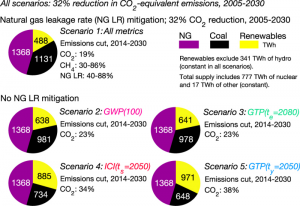by David Chandler, via Energy Post

Natural gas, because it’s low-carbon, is being used as a bridge fuel away from the old fossil fuel world. But there are two main problems. The infrastructure leaks methane (the main component of the gas) which is 25 times more potent than CO2 over a 100-year period (and 86 times over a 20-year period!). And, crucially, nobody is properly measuring those leaks. That means policy makers are growing the gas mix without knowing by how much it’s reducing emissions, argues research summarised here by David Chandler at MIT. The first thing to note is how difficult it is to detect and make those measurements along a complex and varied supply chain that includes wells, storage tanks and pipes. The MIT research brings together data that suggests up to 4.9% of natural gas is lost, some through leaks and some intentionally (venting and flaring). It then presents different policy scenarios, ranging from fixing leaks (but you have to find them all first) to accelerating away from gas to carbon-free power (ignore the leaks, but needs faster clean energy infrastructure build-out). One thing is certain: how can policymakers make informed decisions on our energy mix strategy when our ability to measure the leaks is so poor in the first place? Start by investing in leak detection, says the research.
The uncertain role of natural gas in the transition to clean energy. MIT study finds that challenges in measuring and mitigating leakage of methane, a powerful greenhouse gas, prove pivotal. By David L. Chandler, MIT News
A new MIT study examines the opposing roles of natural gas in the battle against climate change — as a bridge toward a lower-emissions future, but also a contributor to greenhouse gas emissions.
Natural gas, which is mostly methane, is viewed as a significant “bridge fuel” to help the world move away from the greenhouse gas emissions of fossil fuels, since burning natural gas for electricity produces about half as much carbon dioxide as burning coal.